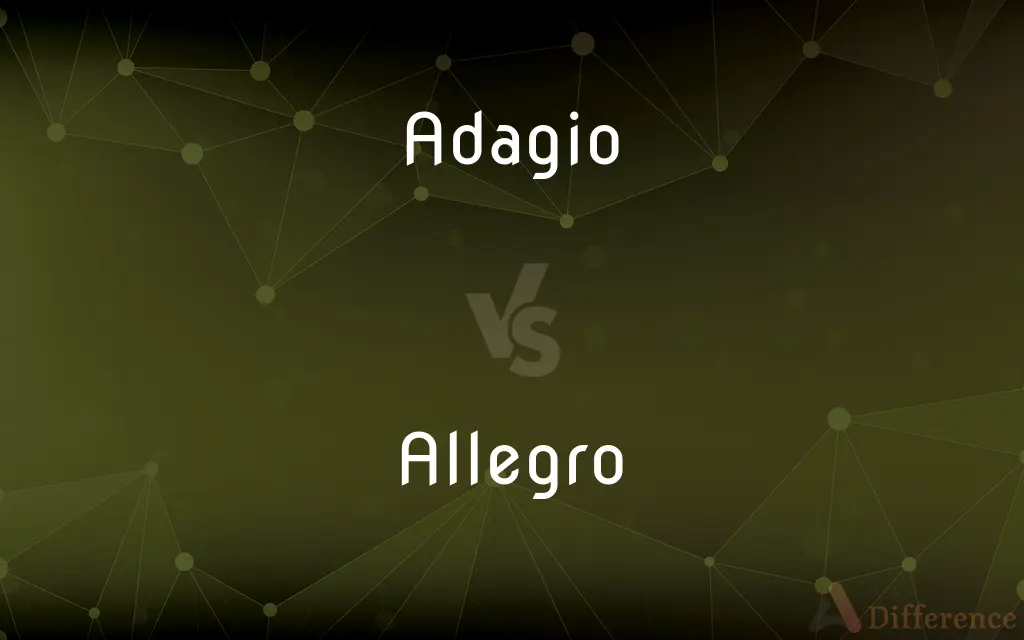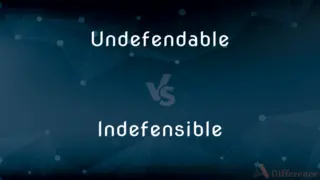Adagio vs. Allegro — What's the Difference?
By Tayyaba Rehman & Maham Liaqat — Updated on March 18, 2024
Adagio is a slow and expressive tempo in music, emphasizing depth and emotion, while Allegro denotes a fast and lively pace, bringing energy and brightness to a piece.

Difference Between Adagio and Allegro
Table of Contents
ADVERTISEMENT
Key Differences
Adagio, in musical terminology, signifies a tempo that is slow and leisurely, allowing for expressive and nuanced performance. This pace enables musicians to delve into the emotional depth of the music, often highlighting the lyrical and melodic aspects. Allegro, on the other hand, is characterized by a brisk and lively tempo. It injects energy and vivacity into a performance, often associated with joyful and vibrant compositions.
In the context of a musical composition, an adagio movement allows for a deeper emotional connection, often serving as a reflective or poignant moment within a larger piece. The slower tempo facilitates a more intimate exploration of the music's thematic elements. Conversely, an allegro movement is designed to elevate the mood, using its rapid pace to bring excitement and dynamism, often propelling the narrative of the piece forward with its spirited rhythm.
The use of adagio in music often corresponds with moments that require a high degree of expressiveness and emotional depth from the performers, showcasing their technical ability to sustain notes and phrases with precision and feeling. In contrast, allegro demands technical agility and energy from the musicians, challenging them to maintain clarity and articulation at a faster pace, which contributes to the overall exhilaration of the performance.
In the broader context of an orchestra or ensemble, an adagio section can provide a moment of respite and reflection, both for the performers and the audience, allowing for a collective appreciation of the music's emotional landscape. An allegro section, whereas, can act as a driving force, bringing a sense of cohesion and momentum to the ensemble, often leading to climactic points in the performance.
The choice between adagio and allegro in a composition reflects the composer's intent to convey specific emotions or narratives. While adagio might be used to evoke a sense of serenity, melancholy, or introspection, allegro is often employed to express joy, excitement, or the bustling energy of a particular scene or emotion.
ADVERTISEMENT
Comparison Chart
Tempo
Slow and leisurely, typically 66–76 BPM.
Fast and lively, often above 120 BPM.
Expression
Emphasizes depth, emotion, and lyricism.
Focuses on energy, brightness, and rhythm.
Performance Demand
Requires control for sustained notes and expressive nuance.
Demands technical agility and clarity at fast speeds.
Emotional Impact
Evokes serenity, melancholy, or introspection.
Conveys joy, excitement, or vigorous energy.
Role in Compositions
Often provides a reflective or poignant moment.
Injects excitement and drives the narrative forward.
Compare with Definitions
Adagio
A slow tempo marking in music, allowing for expressive detail.
The adagio movement in the symphony brought tears to the audience's eyes.
Allegro
A fast tempo marking in music, indicating a lively pace.
The orchestra burst into the allegro, filling the hall with energy.
Adagio
Refers to a slow and graceful ballet movement.
The dancers performed the adagio with exquisite control.
Allegro
A section or movement in a musical composition that is fast-paced.
The symphony's final allegro galvanized the audience.
Adagio
A section of a musical piece that is to be played slowly.
The concerto's adagio was a masterclass in musical phrasing.
Allegro
Denotes a lively and fast tempo that energizes the performance.
The finale's allegro was a whirlwind of sound and excitement.
Adagio
Used to describe music that is played or sung slowly with great emotion.
The adagio passage highlighted the violinist's emotive prowess.
Allegro
Used to describe a rapid and joyful musical expression.
The quartet's allegro captured the joyous essence of the composition.
Adagio
Indicates a leisurely pace in music that allows for expressiveness.
The pianist took the adagio at a beautifully reflective pace.
Allegro
Music that is characterized by a brisk and spirited rhythm.
The allegro sections of the piece were exhilarating.
Adagio
In a slow tempo, usually considered to be slower than andante but faster than larghetto. Used chiefly as a direction.
Allegro
In a quick, lively tempo, usually considered to be faster than allegretto but slower than presto. Used chiefly as a direction.
Adagio
(Music) A slow passage, movement, or work, especially one using adagio as the direction.
Allegro
An allegro passage or movement.
Adagio
A section of a pas de deux in which the ballerina and her partner perform steps requiring lyricism and great skill in lifting, balancing, and turning.
Allegro
A succession of fast jumps performed as an exercise in ballet.
Adagio
A succession of slow, fluid movements performed as an exercise in ballet.
Allegro
(music) A tempo mark directing that a passage is to be played in a quick, lively tempo, faster than allegretto but slower than presto.
Adagio
(music) A tempo mark directing that a passage is to be played rather slowly, leisurely and gracefully.
Allegro
An expressive mark indicating that a passage is to be played in a lively or happy manner, not necessarily quickly.
Adagio
(music) A passage having this mark.
Allegro
(music) A passage having this mark.
Adagio
(dance) A male-female duet or mixed trio ballet displaying demanding balance, spins and/or lifts.
Allegro
(music) played in a quick, lively tempo
Adagio
(music) Played rather slowly.
Allegro
(music) in a quick and lively manner
Adagio
(music) Describing a passage having this mark.
Allegro
Brisk, lively.
Adagio
Slow; slowly, leisurely, and gracefully. When repeated, adagio, adagio, it directs the movement to be very slow.
Allegro
A brisk and lively tempo
Adagio
A piece of music in adagio time; a slow movement; as, an adagio of Haydn.
Allegro
A musical composition or passage performed quickly in a brisk lively manner
Adagio
(music) a composition played in adagio tempo (slowly and gracefully);
They played the adagio too quickly
Allegro
(of tempo) fast
Adagio
A slow section of a pas de deux requiring great skill and strength by the dancers
Allegro
In a quick and lively tempo;
Play this section allegro
Adagio
(of tempo) leisurely
Adagio
Slowly;
Here you must play adagio
Common Curiosities
What is the character of allegro music?
Allegro music is characterized by a fast, lively tempo, often associated with brightness and energy.
What does adagio mean in music?
Adagio refers to a slow and expressive tempo, allowing for depth and emotion in performance.
Is there a tempo range that defines adagio and allegro?
Adagio is typically within 66–76 BPM, while allegro is often above 120 BPM, though these can vary based on interpretation.
How does adagio affect a musical performance?
Adagio allows for a more expressive and nuanced performance, emphasizing the emotional depth of the music.
Can an entire piece be composed in allegro?
Yes, some pieces are composed entirely in an allegro tempo, focusing on vibrancy and rhythm throughout.
What emotional states does adagio typically evoke?
Adagio can evoke a range of emotions, including serenity, melancholy, and introspection, depending on the context.
Can adagio and allegro sections be part of the same piece?
Yes, many compositions feature both adagio and allegro sections, providing contrast and depth.
How does the audience typically respond to adagio music?
Adagio music often elicits a deep emotional response, sometimes leading to moments of reflection or tears.
Is allegro always joyful?
While often associated with joy, allegro can also convey other vigorous emotions, depending on the musical context.
How do musicians prepare for an adagio section?
Musicians prepare by focusing on control, sustained note production, and expressive phrasing.
What challenges do musicians face when performing allegro?
The main challenges include maintaining clarity, articulation, and precision at high speeds.
How do composers decide between adagio and allegro for a piece?
Composers choose based on the emotion or narrative they wish to convey, using adagio for depth and allegro for energy.
How does adagio contribute to the structure of a classical symphony?
In a symphony, an adagio movement often serves as a contrast to faster movements, providing emotional depth and a reflective pause.
What role does allegro play in dance music?
In dance, allegro is used to inject energy and facilitate fast, lively movements.
Can adagio be used in modern music genres?
Yes, the concept of adagio can be applied in modern genres, emphasizing slow, expressive sections.
Share Your Discovery

Previous Comparison
Undefendable vs. Indefensible
Next Comparison
Alert vs. NotifyAuthor Spotlight
Written by
Tayyaba RehmanTayyaba Rehman is a distinguished writer, currently serving as a primary contributor to askdifference.com. As a researcher in semantics and etymology, Tayyaba's passion for the complexity of languages and their distinctions has found a perfect home on the platform. Tayyaba delves into the intricacies of language, distinguishing between commonly confused words and phrases, thereby providing clarity for readers worldwide.
Co-written by
Maham Liaqat















































